Lanzhou University’s JMCC: High-Conductivity Graphene/Carbon Black Ink for Wearable Fabric Heaters and Strain Sensors
Summary of Achievements
Graphene composite conductive inks are promising for the large-scale production of printable electronics and multifunctional coatings due to their cost-effectiveness, strong conductivity, and significant flexibility. However, the re-aggregation of graphene (Gr) sheets and the agglomeration of carbon black (CB) greatly reduce the conductivity of aqueous graphene composite inks, limiting the exploration of high-performance devices. Professor Bai Yongxiao’s team from Lanzhou University published a paper titled “High-conductivity graphene/carbon black inks via interpenetrating networks for wearable fabric-based heaters and strain sensors” in the journal Journal of Materials Chemistry C. The study developed a highly conductive and dispersed graphene composite ink using a scalable grinding method, addressing the aggregation issues of graphene and carbon black through the use of carboxymethyl cellulose (CMC).
The research shows that functionalized Gr and CB can synergistically form interpenetrating conductive network structures. The in-situ exfoliation process promotes the synthesis of highly dispersed Gr/CB composites, achieving a high conductivity of 2.12×10^4 S/m (or 2.16 Ω sq^-1). Screen-printed Gr/CB@thermoplastic polyurethane (TPU) fabric based on Gr/CB composite ink exhibits excellent conductivity (7.08 Ω sq^-1). The resulting composite fabric shows great potential for use in low-voltage-driven wearable heaters and ultra-sensitive flexible strain sensors, with additional features such as waterproofing, stability, and comfort, indicating its immense application potential in flexible wearable electronics.
Graphical Abstract
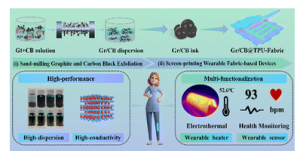
Figure 1: (a) Schematic diagram of producing Gr/CB dispersions through grinding exfoliation and (b) the manufacture and application of multifunctional Gr/CB@TPU-Fabric.
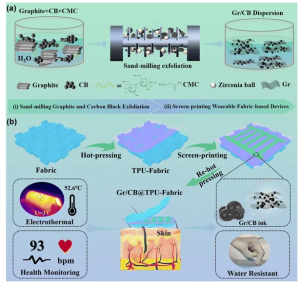
Figure 2: (a) Relationship between exfoliation time and the sheet resistance and conductivity of Gr. (b) Conductivity and sheet resistance of Gr/CB dispersions as a function of CB mass ratio. (c) Conductivity and sheet resistance of Gr, CB, Gr + CB, and Gr/CB dispersions. (d)-(g) TEM images of Gr, CB, Gr + CB, and Gr/CB dispersions. (h) Static sedimentation photographs of Gt + CB, Gr, Gr + CB, and CB after 24 hours, and Gr/CB after 10-90 days. (i) SEM images of exfoliated Gr/CB dispersions. (j)-(n) AFM images and height profiles of exfoliated Gr/CB dispersions.
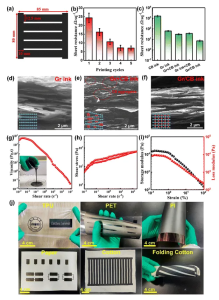
Figure 3: (a) Printed patterns of Gr/CB ink. (b) Relationship between screen printing cycles and sheet resistance on paper. (c) Sheet resistance of CB ink, Gr ink, Gr + CB ink, and Gr/CB ink. (d)-(f) SEM cross-sectional images of Gr ink, Gr + CB ink, and Gr/CB ink screen prints. (g) Viscosity vs. shear rate, (h) shear stress vs. shear rate, and (i) storage modulus and loss modulus vs. strain. (j) Photos of Gr/CB ink printed on TPU, PET, PI, commercial paper, and cotton fabric substrates.
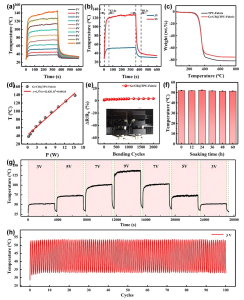
Figure 4: (a) Electrical heating response temperature of Gr/CB@TPU-Fabric under different voltages. (b) Response/recovery time of Gr/CB@TPU fabric at 3 V and 9 V. (c) TGA curves of TPU fabric and Gr/CB@TPU fabric. (d) Relationship between power consumption and steady-state temperature of Gr/CB@TPU fabric. (e) Resistance change of Gr/CB@TPU fabric over 2000 bending cycles. (f) Temperature change of Gr/CB@TPU fabric after soaking in water for different durations. (g) Temperature change of Gr/CB@TPU-Fabric with increasing and decreasing applied voltage. (h) Heating-cooling cycle stability of graphene conductive fabric at 3 V.
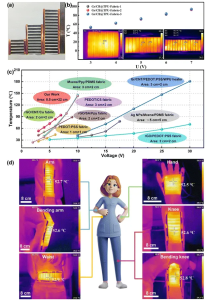
Figure 5: (a) Photos of Gr/CB@TPU-Fabric with different areas. (b) Relationship between voltage and temperature of different areas of Gr/CB@TPU-Fabric. Inset shows infrared thermal images of Gr/CB@TPU-Fabric with different areas at 3 V (8.5 cm × 8 cm, 8.5 cm × 16 cm, and 8.5 cm × 22 cm). (c) Comparison of electrothermal properties and heating area of Gr/CB@TPU-Fabric with previously reported fabric-based heaters. (d) Infrared thermal images of Gr/CB@TPU fabric at 3 V on the hand, waist, arm, and knee.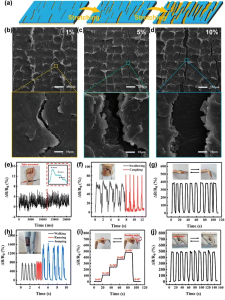
Figure 6: (a) Schematic of the sensing mechanism of the strain sensor based on Gr/CB@TPU-Fabric. SEM images of the strain sensor based on Gr/CB@TPU-Fabric under different tensile strains (b) 1%, (c) 5%, and (d) 10%. Real-time relative resistance change curves of the strain sensor based on Gr/CB@TPU-Fabric during (e) wrist pulse, (f) swallowing and coughing, (g) wrist bending at 90°, (h) walking, running, and jumping, (i) finger bending at different angles, and (j) finger bending in water.
Conclusion
In summary, a highly dispersed conductive Gr/CB composite dispersion was developed using a grinding exfoliation method. Additionally, a high-conductivity ink based on the interpenetrating conductive network structure of Gr and CB was successfully prepared for flexible wearable devices. The fabric-based devices made using this conductive ink exhibit excellent conductivity, low-voltage Joule heating, and strain sensing performance. At a low driving voltage of 3 V, the maximum steady-state temperature of Gr/CB@TPU-Fabric reaches 52.1°C over a large area of 8.5 cm × 22 cm. The strain sensor based on Gr/CB@TPU-Fabric demonstrates extremely high sensitivity (628.62), low detection limit (ε < 0.5%), short response time (87.4 ms), and reliable cycle stability (>2000 cycles). Moreover, the sensor can perform underwater sensing and detection while maintaining good waterproof performance. In conclusion, the proposed Gr/CB composite ink offers an innovative and cost-effective approach for realizing large-scale high-performance electronic devices.

